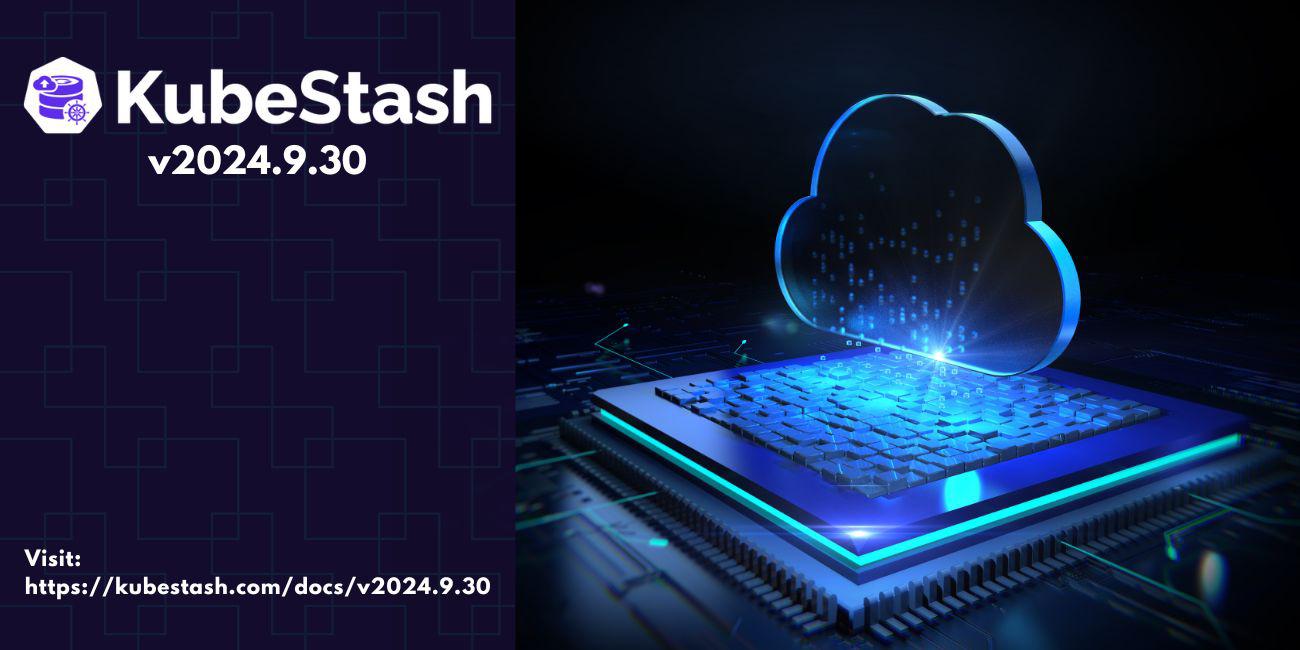
We are very excited to announce the release of KubeStash v2024.9.30 , packed with new features and important bug fixes. You can check out the full changelog HERE .
New Features
Here, we are going to highlight the new features that have been introduced in this release.
KubeDB Managed Druid Database Backup & Restore
We’ve introduced functionality to backup and restore KubeDB managed Druid database. You can take both Logical and Manifest backup of druid clusters separately or both together which we call Application Level backup.
Here is an example of BackupConfiguration that takes Application level backup of a Druid:
apiVersion: core.kubestash.com/v1alpha1
kind: BackupConfiguration
metadata:
name: sample-druid-backup
namespace: demo
spec:
target:
apiGroup: kubedb.com
kind: Druid
name: sample-druid
namespace: demo
backends:
- name: gcs-backend
storageRef:
name: gcs-storage
namespace: demo
retentionPolicy:
name: demo-retention
namespace: demo
sessions:
- name: frequent-backup
scheduler:
schedule: "*/5 * * * *"
jobTemplate:
backoffLimit: 1
repositories:
- name: gcs-druid-repo
backend: gcs-backend
directory: /druid
encryptionSecret:
name: encrypt-secret
namespace: demo
addon:
name: druid-addon
tasks:
- name: manifest-backup
- name: mysql-metadata-storage-backup
Here, mysql-metadata-storage-backup needs to be replaced with postgres-metadata-storage-backup if PostgreSQL is used as metadata storage.
Here is the example of RestoreSession that restores the Druid:
apiVersion: core.kubestash.com/v1alpha1
kind: RestoreSession
metadata:
name: restore-sample-druid
namespace: demo
spec:
manifestOptions:
druid:
restoreNamespace: dev
dbName: restored-druid
dataSource:
repository: gcs-druid-repo
snapshot: latest
encryptionSecret:
name: encrypt-secret
namespace: demo
addon:
name: druid-addon
tasks:
- name: mysql-metadata-storage-restore
- name: manifest-restore
KubeDB Managed SingleStore Manifest Backup & Restore
KubeStash now supports manifest backup and restore for KubeDB managed SingleStore .
Here is an example of a BackupConfiguration for SingleStore manifest backup:
apiVersion: core.kubestash.com/v1alpha1
kind: BackupConfiguration
metadata:
name: sample-singlestore-backup
namespace: demo
spec:
target:
apiGroup: kubedb.com
kind: Singlestore
name: sample-singlestore
namespace: demo
backends:
- name: gcs-backend
storageRef:
namespace: demo
name: gcs-storage
retentionPolicy:
name: demo-retention
namespace: demo
sessions:
- name: frequent-backup
scheduler:
schedule: "*/5 * * * *"
jobTemplate:
backoffLimit: 1
repositories:
- name: gcs-singlestore-repo
backend: gcs-backend
directory: /ss
encryptionSecret:
name: encrypt-secret
namespace: demo
addon:
name: singlestore-addon
tasks:
- name: manifest-backup
Here’s an example of a RestoreSession that restores the manifest of SingleStore:
apiVersion: core.kubestash.com/v1alpha1
kind: RestoreSession
metadata:
name: sample-singlestore-restore
namespace: demo
spec:
manifestOptions:
singlestore:
restoreNamespace: dev
dataSource:
repository: gcs-singlestore-repo
snapshot: latest
encryptionSecret:
name: encrypt-secret
namespace: demo
addon:
name: singlestore-addon
tasks:
- name: manifest-restore
Support for NetworkPolicy
We’ve added support for NetworkPolicy
in the release. Now users can pass --set global.networkPolicy.enabled=true while installing KubeStash. The required Network policies for operator will be created as part of the release process.
Support for External Databases Backup/Restore
We’ve added backup and restore support for external PostgreSQL, MySQL, and Elasticsearch databases. You can now back up any cloud-hosted databases, including those on DigitalOcean, AWS RDS, and Google Cloud SQL, and easily restore them as needed.
Below given a procedure how to backup and restore of any external database. We are going to show MYSQL for an example. The process is similar for other databases as well.
Secret
Here is an example of Secret with database authentication credentials,
apiVersion: v1
kind: Secret
metadata:
name: db-mysql-credentials-secret
namespace: demo
type: Opaque
stringData:
password: <auth_password>
username: <auth_username>
AppBinding
KubeStash uses the AppBinding CR to connect with the target database.
Here, is an example of an AppBinding object that contains the necessary information to connect to the database.
apiVersion: appcatalog.appscode.com/v1alpha1
kind: AppBinding
metadata:
name: db-mysql-appbinding
namespace: demo
spec:
clientConfig:
url: mysql://kubestash-test-do-user-165729-0.g.db.ondigitalocean.com:25060/defaultdb?ssl-mode=require
secret:
name: db-mysql-credentials-secret
type: mysql
version: "8.0.3"
BackupConfiguration
Here is an example of a BackupConfiguration object for backing up an externally managed MySQL database.
apiVersion: core.kubestash.com/v1alpha1
kind: BackupConfiguration
metadata:
name: mysql-db-backup
namespace: demo
spec:
target:
apiGroup: appcatalog.appscode.com
kind: AppBinding
name: db-mysql-appbinding
namespace: demo
backends:
- name: gcs-backend
storageRef:
namespace: demo
name: gcs-storage
retentionPolicy:
name: demo-retention
namespace: demo
sessions:
- name: frequent-backup
sessionHistoryLimit: 3
scheduler:
schedule: "*/5 * * * *"
successfulJobsHistoryLimit: 1
failedJobsHistoryLimit: 1
jobTemplate:
backoffLimit: 1
repositories:
- name: gcs-mysql-repo
backend: gcs-backend
directory: /mysql
encryptionSecret:
name: encrypt-secret
namespace: demo
addon:
name: mysql-addon
tasks:
- name: logical-backup
params:
args: --single-transaction --set-gtid-purged=OFF
databases: playground
RestoreSession
Here is an example of a RestoreSession object for restoring an externally managed MySQL database.
apiVersion: core.kubestash.com/v1alpha1
kind: RestoreSession
metadata:
name: mysql-restoresession
namespace: demo
spec:
target:
apiGroup: appcatalog.appscode.com
kind: AppBinding
name: db-mysql-appbinding
namespace: demo
dataSource:
repository: gcs-mysql-repo
snapshot: latest
encryptionSecret:
name: encrypt-secret
namespace: demo
addon:
name: mysql-addon
tasks:
- name: logical-backup-restore
Improvements & Bug Fixes
Updated Declarative API
We’ve updated the declarative API for BackupConfiguration and RestoreSession in KubeStash. The spec.sessions[*].timeout field has been removed from BackupConfiguration and replaced with spec.sessions[*].backupTimeout, which sets the maximum duration for the backup as a deadline. KubeStash now wraps the backup command(s) with a timeout according to the deadline. If the backup doesn’t finish within this time, the Snapshot and BackupSession should be marked as Failed. You should also find a deadline exceeded or signal terminated error message in the Snapshot status. By default, no backup timeout is set.
Similarly, the spec.timeout field has been removed from RestoreSession and replaced with spec.restoreTimeout which sets the maximum duration for the restore as a deadline. KubeStash now wraps the restore command(s) with a timeout according to the deadline. If the restore doesn’t finish within this time, the RestoreSession should be marked as Failed. You should also find a deadline exceeded or signal terminated error message in the RestoreSession status. By default, no restore timeout is set.
Handling Unexpected failures for Backup Or Restore
We’ve fixed a bug that caused the BackupSession to remain in the running phase when the backup/restore container failed unexpectedly with an error (i.e. OOMKill).
Content-Type Handling for YAML Uploads to Object Storage
We’ve fixed a bug while uploading YAML file to S3 compatible Dell ECS Enterprise Object Storage. Now, we include the Content-Type when uploading any YAML file to the cloud storage.
What Next?
Please try the latest release and give us your valuable feedback.
- If you want to install KubeStash in a clean cluster, please follow the installation instruction from HERE .
- If you want to upgrade KubeStash from a previous version, please follow the upgrade instruction from HERE .
Support
To speak with us, please leave a message on our website .
To receive product announcements, follow us on Twitter/X .









